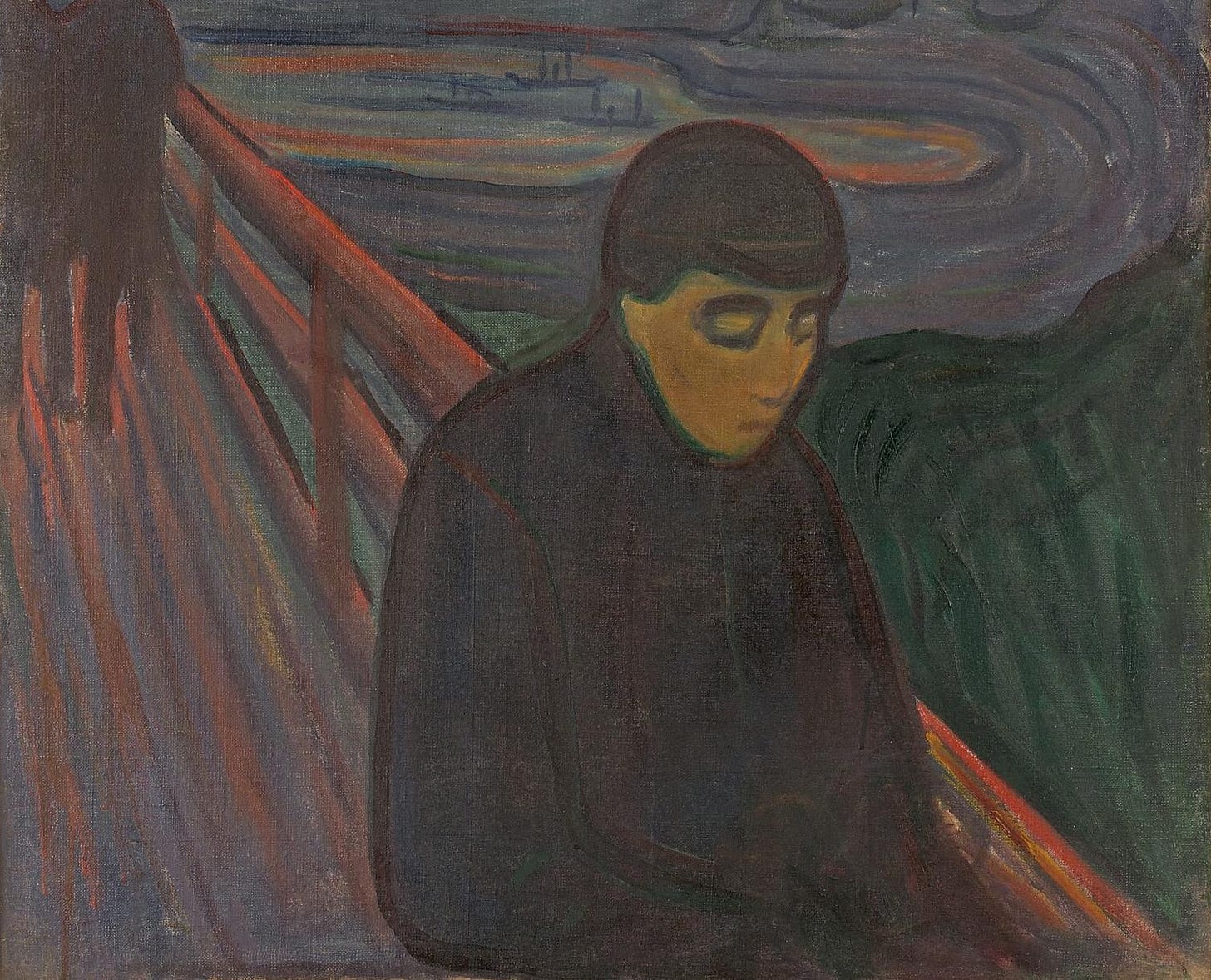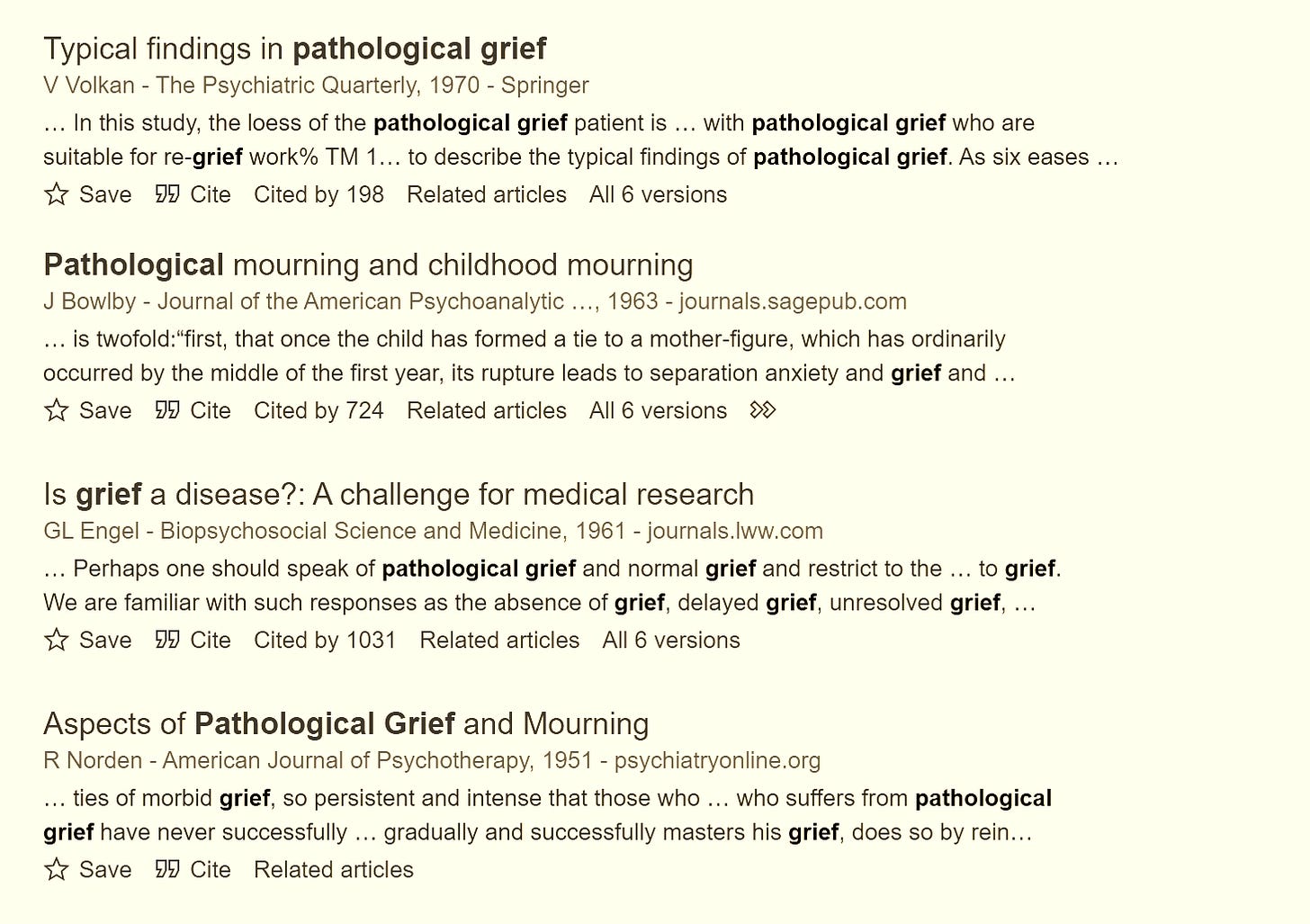In Defense of Disordered Grief
No, grief has not been given an expiration date
“The distinguishing mental features of melancholia are a profoundly painful dejection, cessation of interest in the outside world, loss of the capacity to love, inhibition of all activity, and a lowering of the self-regarding feelings to a degree that finds utterance in self-reproaches and self-revilings, and culminates in a delusional expectation of punishment. This picture becomes a little more intelligible when we consider that, with one exception, the same traits are met with in mourning… It is really only because we know so well how to explain it that this attitude does not seem to us pathological.”
Sigmund Freud, Mourning and Melancholia (1917)
Many people think of psychiatric diagnoses as working similarly to descriptive diagnoses in medicine, such as obesity, essential hypertension, or prediabetes. There is an operationalized description (e.g. BMI ≥30 or HbA1c level of 5.7% to 6.4%) and if that description applies to you, you have that condition, whether you like it or not, whether you agree or not. In the eyes of the medical community, you now have it, regardless of how you feel about it.
Psychiatric diagnoses—accurately understood (which can’t always be taken for granted, unfortunately)—don’t work that way. This is because psychiatric diagnoses also come with additional requirements such as “clinical significance,” “distress or impairment in social, occupational, or other important areas of functioning,” and in some cases, the severity and duration must “clearly exceed expected social, cultural, or religious norms for the individual’s culture and context.” These qualifications transform the nature of diagnosis in ways poorly appreciated even by physicians.
Consider grief in its pathological varieties with two hypothetical scenarios.
Scenario A. A 45-year-old man comes to a therapist for help. His wife passed away two years ago, suddenly and unexpectedly, and his life has come to a standstill. He finds her loss unbearable. He breaks down sobbing any time someone mentions her. He is barely functioning at work and is at risk of being fired. He has withdrawn from his children because they remind him too much of his wife, and grandparents have had to step in to make sure the kids are taken care of. He constantly replays what-if scenarios in his mind and believes he should’ve died with her. He cannot imagine being in a romantic relationship with another person ever again. He was in denial for a long time, but he has finally begun to recognize, “I am stuck, I am suffering. This is not healthy. My wife would not want this for me. I need help.”
Scenario B. A woman sees her psychiatric provider for a routine visit. She periodically meets him for refills of her anxiety and depression meds. She lost her husband a year ago, and she is still grieving. A year later the wound still seems fresh, and the grief comes and goes in waves. During some intense moments she finds herself wondering if she should’ve moved on by now, but she is otherwise functioning well and has friends and a supportive, loving family. The provider asks some screening questions based on the symptoms listed in the diagnostic criteria for prolonged grief disorder. She endorses three symptoms as being present some of the time, and the provider says, “You have prolonged grief disorder. It has been a year and you are still grieving. You should see a therapist to work on that.” The woman is taken aback. “Doesn’t everyone grieve in their own way, on their own timeline?” She asks. “Not anymore,” he replies, “The bible of psychiatry says grief is disordered after a year.”
Scenario B is an intentional caricature. The provider basically gets every detail wrong about prolonged grief disorder and is shit at talking to patients. I don’t know if anything like that has ever happened, but that’s what a lot of people imagine when they hear about prolonged grief disorder. Prolonged grief disorder is now in the DSM?! We are medicalizing too much! Pathologization has gone out of control! How can you ever say grief can be disordered, do doctors have no shame?
People hear the word “disorder” and talk about the culture of pathologization, and they feel dehumanized in their bones. They imagine some gruff clinician behaving like the provider in scenario B. They conjure up scenarios of epistemic violence.
Except, it doesn’t work that way.
“There’s no modern cultural framework for dealing with death. We hide it, sanitize it, convince ourselves we have the technology to outsmart it… Is it any wonder, then, that I’ve walked for miles with my baby daughter in her stroller, away from the gaze of family and friends, to keep my grief off display? So I can weep until my throat is raw. So I can sweat and scream until I’m filthy with rage. I duck into the bathroom at work whenever I feel tears coming, splash cold water on my face, and, ten seconds later, walk out with a smile and a wave to whoever is in the hallway.”
Stillman’s grievance is legitimate and heartfelt. Something has gone wrong in our cultural attitudes towards grief. We all know it and feel it. Stillman sees the diagnosis of ‘Prolonged Grief Disorder’ in the DSM as emblematic of this. There is a coherent and plausible case to be made for that, certainly, but in the process, Stillman also misunderstands the nature of prolonged grief disorder as a diagnosis. I understand and respect and admire the time-honored tradition of a writer embracing their suffering, finding something valuable and sacred in it, and rejecting diagnostic attempts at categorization or operationalization. I get it.
What are the diagnostic criteria for prolonged grief disorder? Here’s how Naomi Simon & Katherine Shear describe them in a 2024 article for the New England Journal of Medicine:
“The symptoms of prolonged grief disorder must persist for a minimum period of time (≥6 months according to ICD-11 criteria and ≥12 months according to DSM-5) and cause clinically significant distress or impaired functioning that exceeds expectations for grief in the context of the patient’s cultural, religious, or social community. ICD-11 includes examples of key symptoms of emotional pain, such as sadness, guilt, anger, inability to feel positive emotions, emotional numbness, denial or difficulty in accepting the death, feeling that a part of oneself has been lost, and reduced engagement in social or other activities. The DSM-5 criteria for prolonged grief disorder specifies that at least three of the following eight symptoms be present: intense emotional pain, numbness, intense loneliness, a loss of sense of self (identity disruption), disbelief, avoidance of reminders of the permanence of the loss, trouble reengaging in activities and relationships, and feeling that life is meaningless.”
Prolonged grief disorder is a bit of a misnomer because it puts the primary emphasis on time duration in a manner that is misleading. I myself prefer “complicated grief” or “pathological grief.”
The time duration requirement is widely misunderstood. DSM and ICD have not set a timeline for normal grief. The DSM recognizes that grief isn’t automatically a disorder after one year and doesn’t set any rigid timelines for normal grief. DSM-5-TR notes: “Although in general this time frame reliably discriminates normal grief from grief that continues to be severe and impairing, the duration of adaptive grief may vary individually and cross-culturally.”
The 1-year requirement in the DSM or 6-month requirement in the ICD is necessary but not sufficient. (As a necessary criterion, these duration requirements are in fact rather restrictive. Grief in its pathological varieties can often be identified earlier than that.) Other conditions need to be met, including symptom severity, clinical significance, and deviation from sociocultural norms. The only thing the one-year requirement says is that it can’t be prolonged grief disorder before one year. It doesn’t mean that anything after one year is abnormal.
The clinical significance, functional impairment, and deviation from sociocultural norms criteria mean that you cannot be diagnosed just because you experience intense or frequent grief. The point in both DSM and ICD is maladaptation and stuckness, not the passage of a fixed interval of time or a certain number of symptoms. Most grieving people do not meet these criteria.
The recognition that some instances of grief veer off course and enter pathological territory is not new. It goes back at least to Freud himself. John Bowlby, the father of attachment theory, recognized pathological grief. In an article on the history and status of prolonged grief, Holly G. Prigerson and colleagues (2021) note:
“Bowlby considered the inability to arrive at the final stage of normal grief— that is, the ability to relinquish persistent yearning for the attachment figure, accept the loss, and become emotionally attached to others—to constitute pathological grieving. More specifically, the four types of pathological mourning Bowlby proposed in 1963 included (a) a persistent yearning to recover the lost object, (b) a persistent anger at both others and the self, (c) compulsive caring for another bereaved person with whom they identified, and (d) denial of the reality of the loss. For Bowlby, the adult mourner’s unresolved rage and protest over the loss of the love object was the essence of pathological mourning (Bowlby 1963).”
So no, we cannot attribute the creation of disordered grief to a “makeshift consensus group clad in tweed in some back room at a Psychiatric conference.”
If you search on Google Scholar, you will see titles from the 1950s, 1960s, and 1970s:
I have also seen many people with pathological grief in the clinic over the years. I remember one woman vividly. Her daughter died unexpectedly as a young adult, and the untimely death of her daughter devastated her. By the time I saw her, one and a half years had passed, and she was a nonfunctional, emotional mess. She couldn’t stop crying. She couldn’t keep a job. Her husband left her. Thoughts of her daughter were so distressing that she developed a severe addiction in an effort to numb her pain. It is easy to pooh-pooh complex, persistent grief without coming to terms with the reality of suffering people.
There are good reasons why grieving people can bristle at talk of disordered or pathological grief. Many grieving people harbor anxieties about if they are “doing grief right,” and the existence of grief as a disorder becomes another guidepost they have to contend with. Calling grief “disordered” can feel like a critique of love itself. The grief protects the continuing bond in the grieving person’s mind and expectations around disordered grief can sound like pressure to “move on,” which feels like betrayal. People are wary of normative policing and they fear that ordinary oscillations of grief will be misread as illness. These are all genuine worries.
But if we are being honest and if we want to give people the dignity of care, we have to recognize that we need to carve out a clinical space for grieving folks who are suffering and stuck and want help. And that means giving it a clinical name, even if it means that the rest of us have to contend with our anxieties around the existence of that name.
See also:
A History of Prolonged Grief Disorder's Inclusion in the DSM — And What Is Missing From It
The article “Prolonged Grief Disorder and the DSM: A History” by Zachar, First, and Kendler (Journal of Nervous and Mental Disease, 2023) provides a fascinating behind-the-scenes account of how Prolonged Grief Disorder (PGD) made it into the DSM and of the debates that took place within the complicated/prolonged grief research communities and the releva…






I find this interesting. What I wonder about is whether some losses are pathological in themselves, and whether putting the emphasis on how that person responds is appropriate. I have also treated someone who had traumatically lost a daughter two years earlier. At the time, my own daughter was young. Even now, as a parent, it seems to me the loss of a child is wrong, unexpected, unacceptable, and can only be imagined to cause pathological suffering. Maybe it doesn't matter what the label is, but there are some losses from which people cannot return to baseline.
Thanks for this post, Awais. Grief is so awful! And it is so misunderstood by scientists who try to make it more consistent than it is.
I spent three years getting funding and recruiting grief expert collaborators to analyze of one of the best prospective studies of grief ever conducted in hopes of understanding how low mood is useful. (the CLOC study https://www.icpsr.umich.edu/web/ICPSR/studies/3370)
I concluded that there is no way to define "normal" grief, its variations are manifold. A third of our subjects had little or no grief; in contrast to my hypothesis, most of them seemed to have good relationships and stable lives. A third had regular grief with all its variations in symptoms and sequence. A third had a harder time and longer symptoms, but still lots of variation. The best predictor was previous low mood and depression. We found no evidence that delayed grief led to bad outcomes, and what I was taught in psychiatry residency-that prolonged grief was a product of an ambivalent relationship-was just plain wrong. Surviving spouses with ambivalent relationships had less grief than others.
As for evolution and grief, I remain uncertain if it is an adaptation or an epiphenomenon of attachment and the broader capacity for sadness. More work is needed.
Details available at https://www.randolphnesse.com/articles/grief